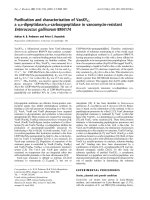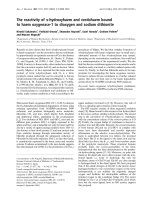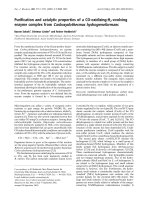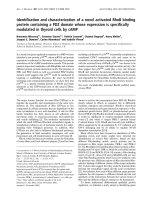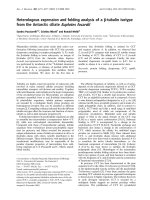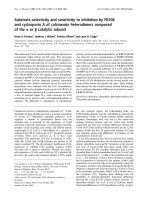Báo cáo y học: "Traditional electrosurgery and a low thermal injury dissection device yield different outcomes following bilateral skin-sparing mastectomy: a case report" ppt
Bạn đang xem bản rút gọn của tài liệu. Xem và tải ngay bản đầy đủ của tài liệu tại đây (1020.21 KB, 5 trang )
CAS E REP O R T Open Access
Traditional electrosurgery and a low thermal
injury dissection device yield different outcomes
following bilateral skin-sparing mastectomy:
a case report
Richard E Fine
1
and Joshua G Vose
2*
Abstract
Introduction: Although a skin- and nipple-sparing mastectomy technique offers distinct cosmetic and
reconstructive advantages over traditional me thods, partial skin flap and nipple necrosis remain a significant source
of post-operative morbidity. Prior work has suggested that collateral thermal damage resulting from electrocautery
use during skin flap development is a potential source of this complication. This report describes the case of a
smoker with recurrent ductal carcinoma in situ (DCIS) who experienced significant unilateral skin necrosis following
bilateral skin-sparing mastectomy while participating in a clinical trial examining mastectomy outcomes with two
different surgical devices. This unexpected complication has implications for the choice of dissection devices in
procedures requiring skin flap preservation.
Case presentation: The patient was a 61-year-old Caucasian woman who was a smoker with recurrent DCIS of
her right breast. As part of the clinical trial, each breast was randomized to either the standard of care treatment
group (a scalpel and a traditional electrosurgical device) or treatment with a novel, low thermal injury dissection
device, allowing for a direct, internally controlled comparison of surgical outcomes. Post-operative follow-up at six
days was unremarkable for both operative sites. At 16 days post-surgery, the patient presented with a significant
wound necrosis in the mastectomy site randomized to the control study group. Following debridement and
closure, this site progressively healed over 10 weeks. The contralateral mastectomy, randomized to the alternative
device, healed normally.
Conclusion: We hypothesize that thermal damage to the subcutaneous microvasculature during flap dissection
may have contributed to this complication and that the use of a low thermal injury dissection device may be
advantageous in select patients undergoing skin- and nipple-sparing mastectomy.
Introduction
Primarily because of inherent cosmetic and reconstruc-
tive advantages, the use of a skin- and nipple-sparing
surgical technique during mastectomy is increasingly
prevalent, especially for prophylactic mastectomy [1,2].
However, partial necrosis of the skin flap and/or nipp le-
areola complex is relatively common, affecting approxi-
mately 10% to 20% of patients [1-7]. Evidence suggests
that thermal injury to the subcutaneous microvascular
supply caused during electrosurgical dissection of the
skin flap may be a contributing factor [1]. This compli-
cation represents a significant source of post-operative
morbidity and a barrier to nipple preservation and op ti-
mal cosmetic outcome.
We are currently conducting the first prospective, ran-
domized, controlled study to evaluate the use of the
PEAK PlasmaBlade (PEAK Surgical, Inc., Palo Alto, CA,
USA) in simple mastectomy without immediate recon-
struction. The PlasmaBlade is a US Food and Drug
Administration-cleared and CE-marked, low-tempera-
ture tissue dissection device that uses pulsed radiofre-
quency energy discharges in conjunction with a highly
* Correspondence:
2
PEAK Surgical, Inc., 2464 Embarcadero Way, Palo Alto, CA 94303, USA
Full list of author information is available at the end of the article
Fine and Vose Journal of Medical Case Reports 2011, 5:212
/>JOURNAL OF MEDICAL
CASE REPORTS
© 2011 Fine and Vo se; licensee BioMed Central Ltd. This is an Open Access article distributed under the terms of the Creative
Commons Attribution License ( which permits unrestricted use, distribution, and
reprodu ction in any medium, provided th e original work is properly c ited.
insulated electrode design to cut with simultaneous
hemostasis and approximately 75% less depth of thermal
damage than traditional electrosurgical (that is, “ Bovie”)
devices [8-10]. Because the PlasmaBlade device is priced
competitively with comparable advanced electrosurgery
systems ($200 to $300), it represents a cost-e ffective
treatment alternative. Traditional electrosurgery devices
(about $20) are significantly less expensive. In this trial,
the two ope rative sides of each bilateral simple mastect-
omy were randomized to either the PlasmaBlade or stan-
dard of care (SOC; scalpel and electrosurgery) treatment
groups, allowing for a direct, internally controlled com-
parison of outcomes with the use of the two different
surgical instruments. The primary and secondary end-
points for the study are total serous drain output, post-
operative Visual Analog Scale pain scores and narcotic
consumption. While the data concerning these endpoints
are still being collected and analyzed, we report herein
the sole incidence of skin flap necrosis as an adverse
event in the control (SOC) group and discuss its implica-
tions with respect to the use of traditional electrosurgical
devices during skin- and nipple-sparing mastectomy.
Case presentation
A 61-year-old Caucasian woman with a 17.5 pack year
history of smoking presented with recurrent right-sided
ductal carcinoma in situ (DCIS) one year after lumpect-
omy, partial breast irradiati on, and sequential treatment
with tamoxifen and raloxifene. In addition to a right-
sided mastectomy with sentinel lymph node biopsy, the
patient chose a prophylactic left-sided mastectomy and
declined reconstruction. After we obtained her informed
consent, the patient was included in the comparative
surgery clinical trial (ClinicalTrials.gov Identifier:
NCT00943605). This study was approved by the institu-
tional review board of WellStar Kennestone Hospital
(Marietta, GA, US A) and is being conducted in accor-
dance with all ethi cal standa rds for human clinical
research. According to the randomization protocol, SOC
was used for the left-sided (prophylactic) mastectomy
and the Plasm aBlade was used for the right-sid ed (inter-
ventional) mastectomy with sentinel lymph node biopsy.
Anesthesia was induced, and the patient was prepared
and draped in the usual sterile fashion. For the left-
sided mastectomy, an elliptical, Y-V advancement flap-
type incision was made laterally using a number 10 scal-
pel blade to minimize t he risk of a dog-eared deformity
resulting from a large deposit of subcutaneous fat. The
tissue flaps were developed down to the muscle fascia
with a traditional electrosurgical device set on Coag
35W (Valleylab E2516 Electrosurgical Pencil with
E1551X standard stainless steel electrode and Force-
Triad™ Generator; Valleylab, Inc., Boulder, CO, USA).
Using the same instrument and settings, the breast was
dissected off the chest wall in a mediolateral direction
with the pectoralis fascia included. The remaining
attachments of the breast to the serratus anterior were
divided and followed superiorly to the base of the axilla.
The incision was reapproximated using 5-0 and 4-0
polydioxanone sutures and 1-inch S teriStrip™ adhesive
skin closures (3M, Inc., St Paul, MN, USA). Tegaderm™
transparent dressing ( 3M, Inc.) and Telfa™ Ouch less
non-adherent dressing (Covidien, Inc., Mansfield, MA,
USA) were used for the dressing.
Prior to incision of the right breast, 2mL of methylene
blue diluted with 3mL of normal saline were injected
into the subareolar region. The PEAK PlasmaBlade 4.0
with PULSAR Generator (PEAK Surgical, Inc.) was then
used to create a standard elliptical skin incision (Cut 5:
2W) and to develop the subcutaneous dissection down
to the muscle fascia (Cut 6 for dissection and Coag 7
for bleeding control). The breast was then dissected off
the chest wall, and the incision was closed a nd dressed
in a similar fashion to the left breast. The patient left
the operating room in stable condit ion and was dis-
charged to home the following morning. The total e sti-
mated blood loss from both sides was 50mL.
Intra-operative and post-surgical pathology indicated
that the DCIS w as non-invasive, with no evidence of
disease in the left breast or the right sentinel lymph
nodes. The patient was first followed up six days after
surgery, and both operative sites were noted to be heal-
ing well, with good contou r and skin edges approximat-
ing as expected (Figure 1). However, at 16 days
following surgery, the patient presented with drainage
from her incision and an approximately 9cm
2
area of
necrosis directly superior to the left mastectomy (SOC)
incision line (Figure 2). The surgical site on the right
Figure 1 Healing progress 11 days post-mastectomy. (A)
PlasmaBlade. (B) Standard of care (SOC; scalpel and traditional
electrosurgery). Note increased erythema and ecchymosis on the
SOC side.
Fine and Vose Journal of Medical Case Reports 2011, 5:212
/>Page 2 of 5
side was noted to be clean, dry, and intact. Although the
patient was afebrile, amoxicillin-clavulanate prophylaxis
was prescribed, and, upon further examination and deb-
ridement, the wound was found to undermine in all
directions, extending to the sternum and axilla. Subse-
quently, complete revision and closure of the incision
was performed. Following these interventions, the
wound healed progressively over the next seven weeks
(Figure 3), although a 2cm
2
area reopened before heal-
ing compl etely approximately 10 weeks post-operatively
(Figure 4).
Discussion
While malignant tissue resection remains the prima ry
objective of mastectomy, the secondary goals of
uncomplicated healing and optimal cosmesis are of
paramount importance to the patient. Traditional elec-
trosurgical instruments are widely used in general sur-
gery, chiefly for their efficient bleeding control and
dissection capability. However, this surgical efficiency
comes at a price: the creation of a deep zone of thermal
damage to adjacent tissues that has been associated with
delayed wound healing, increased inflammation, and
cosmetically unacceptable skin scarring [11-15].
Although the use of traditiona l devices is accep table for
the majority of surgical procedures, the inherent thermal
damage profile may outweigh any p otential benefit in
select procedures and patient groups. Specifically, during
flap development in skin- and nipple-sparing mastect-
omy, this collateral tissue damage may inadvertently
destroy enough of the superficial vascular supply to
impair skin flap viability [1].
On the basis of infrared analysis, it has been demon-
strated that the cutting surface of the PlasmaBlade oper-
ates at a temperature between 40°C and 100°C,
compared to 250°C to 350 °C for tradit ional electrosurgi-
cal electrodes [9]. Consistent with this finding, pre-clini-
cal and clinical models of cutaneous wound healing
have shown that use of the PlasmaBlade enables the sur-
geon to incise tissue with the precision of a scalpel and
the bleeding control of traditional electrosurgery, but
with reduced thermal damage that results in improved
wound-healing dynamics [9,10,16,17]. The results of the
case reported here, in which the differential healing of
mastectomy wounds treated with the PlasmaBlade and
traditional electrosurgery was observed, are consistent
with t hese previous findings. We hypothesize that
unappreciated thermal damage to the subcutaneous
Figure 2 Healing progress 16 days post-mastectomy .
Presentation of significant wound necrosis on the SOC side.
Figure 3 Healing progress seven weeks post-mastectomy. (A) Healed PlasmaBlade mastectomy. (B) Improved healing on the SOC side with
noted small area of residual eschar.
Fine and Vose Journal of Medical Case Reports 2011, 5:212
/>Page 3 of 5
microvasculature of the control treatment side in a
patient with a noted history o f tobacco use m ay have
contributed to significant skin flap necrosis and delayed
healing.
Conclusion
The use of low thermal injury electrosurgical instru-
ments for subcutaneous dissection may help to reduc e
the risk of skin flap necrosis following mastectomy in
select patient groups. In addition, more durable investi-
gations examining this specific hypothesis should be
undertaken.
Patient’s perspective
“I had such a hard time with the left side. T he pain was
terrible. I was horrified and very depressed. My left side
is still sore. My right side is perfect, no pain at all. I had
expected and hoped both sides would have been as
good as the right side.”
Consent
Written informed consent was obtained from the patient
for publicatio n of this case report and any accompany-
ing images. A copy of the written consent is availabl e
for review by the Editor-in-Chief of this journal.
Abbreviations
DCIS: ductal carcinoma in situ; SOC: standard of care (scalpel and
electrosurgery).
Acknowledgements
At the time of the events described in this report, the patient was
participating in a clinical trial sponsored by PEAK Surgical, Inc. Jeanne
McAdara-Berkowitz, PhD, provided writing assistance, for which she received
compensation from PEAK Surgical, Inc. Dominique Y Atmodjo, CCRP, and
Beth Boyd, RN, provided additional assistance with manuscript and figure
preparation. The authors maintained full control over the conception,
acquisition, and interpretation of data as well as critical review and final
approval of this report for publication.
Author details
1
WellStar Kennestone Hospital, 677 Church Street, Marietta, GA 30060, USA.
2
PEAK Surgical, Inc., 2464 Embarcadero Way, Palo Alto, CA 94303, USA.
Authors’ contributions
REF is the principal investigator for the clinical trial described in this report.
He performed the mastectomy procedures, conducted patient follow-up,
and was a major contributor to the writing of the manuscript. JGV was a
major contributor to the design of the clinical trial and to the writing of the
manuscript. Both authors read and approved the final manuscript.
Competing interests
REF is a consultant to PEAK Surgical, Inc. JGV is the Medical Director of PEAK
Surgical, Inc.
Received: 21 February 2011 Accepted: 28 May 2011
Published: 28 May 2011
References
1. Rusby JE, Smith BL, Gui GP: Nipple-sparing mastectomy. Br J Surg 2010,
97:305-316.
2. Wijayanayagam A, Kumar AS, Foster RD, Esserman LJ: Optimizing the total
skin-sparing mastectomy. Arch Surg 2008, 143:38-45.
3. Chun YS, Verma K, Rosen H, Lipsitz SR, Breuing K, Guo L, Golshan M,
Grigorian N, Eriksson E: Use of tumescent mastectomy technique as a risk
factor for native breast skin flap necrosis following immediate breast
reconstruction. Am J Surg 2010, 201:160-165.
4. Davies K, Allan L, Roblin P, Ross D, Farhadi J: Factors affecting post-
operative complications following skin sparing mastectomy with
immediate breast reconstruction. Breast 2010, 20:21-25.
5. Hongying WU, Shan ZC, Thakuri B: Origin and countermeasure for
common skin flap complications after radical operation for breast
cancer. Kathmandu Univ Med J (KUMJ) 2006, 4:14-17.
6. Komorowski AL, Zanini V, Regolo L, Carolei A, Wysocki WM, Costa A:
Necrotic complications after nipple- and areola-sparing mastectomy.
World J Surg 2006, 30:1410-1413.
7. Olsen MA, Lefta M, Dietz JR, Brandt KE, Aft R, Matthews R, Mayfield J,
Fraser VJ: Risk factors for surgical site infection after major breast
operation. J Am Coll Surg 2008, 207:326-335.
8. Jacobson MT: Pulsed electron avalanche knife PlasmaBlade. Expert Rev
Obstet Gynecol 2010, 5:19-22.
9. Loh SA, Carlson GA, Chang EI, Huang E, Palanker D, Gurtner GC:
Comparative healing of surgical incisions created by the PEAK
PlasmaBlade, conventional electrosurgery, and a scalpel. Plast Reconstr
Surg 2009, 124:1849-1859.
10. Palanker DV, Vankov A, Huie P: Electrosurgery with cellular precision. IEEE
Trans Biomed Eng 2008, 55:838-841.
11. Arashiro DS, Rapley JW, Cobb CM, Killoy WJ: Histologic evaluation of
porcine skin incisions produced by CO
2
laser, electrosurgery, and
scalpel. Int J Periodontics Restorative Dent 1996, 16:479-491.
12. Butler PE, Barry-Walsh C, Curren B, Grace PA, Leader M, Bouchier-Hayes D:
Improved wound healing with a modified electrosurgical electrode. Br J
Plast Surg 1991, 44:495-499.
13. Massarweh NN, Cosgriff N, Slakey DP: Electrosurgery: history, principles,
and current and future uses. J Am Coll Surg 2006, 202:520-530.
14. Pollinger HS, Mostafa G, Harold KL, Austin CE, Kercher KW, Matthews BD:
Comparison of wound-healing characteristics with feedback circuit
electrosurgical generators in a porcine model. Am Surg 2003,
69:1054-1060.
15. Vore SJ, Wooden WA, Bradfield JF, Aycock ED, Vore PL, Lalikos JF,
Hudson SS: Comparative healing of surgical incisions created by a
standard “bovie,” the Utah Medical Epitome Electrode, and a Bard-
Parker cold scalpel blade in a porcine model: a pilot study. Ann Plast
Surg 2002, 49:635-645.
16. Chang EI, Carlson GA, Vose JG, Huang EJ, Yang GP: Comparative healing of
rat fascia following incision with three surgical instruments. J Surg Res
2011, 167:e47-e54.
Figure 4 Healing progress 10 weeks post-mastectomy showing
complete healing of both operative sites.
Fine and Vose Journal of Medical Case Reports 2011, 5:212
/>Page 4 of 5
17. Ruidiaz ME, Messmer D, Atmodjo DY, Vose JG, Huang EJ, Kummel AC,
Rosenberg HL, Gurtner GC: Comparative healing of human cutaneous
surgical incisions created by the PEAK PlasmaBlade, conventional
electrosurgery, and a standard scalpel. Plast Reconstr Surg 2011.
doi:10.1186/1752-1947-5-212
Cite this article as: Fine and Vose: Trad itional electrosurgery and a low
thermal injury dissection device yield different outcomes following
bilateral skin-sparing mastectomy: a case report. Journal of Medical Case
Reports 2011 5:212.
Submit your next manuscript to BioMed Central
and take full advantage of:
• Convenient online submission
• Thorough peer review
• No space constraints or color figure charges
• Immediate publication on acceptance
• Inclusion in PubMed, CAS, Scopus and Google Scholar
• Research which is freely available for redistribution
Submit your manuscript at
www.biomedcentral.com/submit
Fine and Vose Journal of Medical Case Reports 2011, 5:212
/>Page 5 of 5




